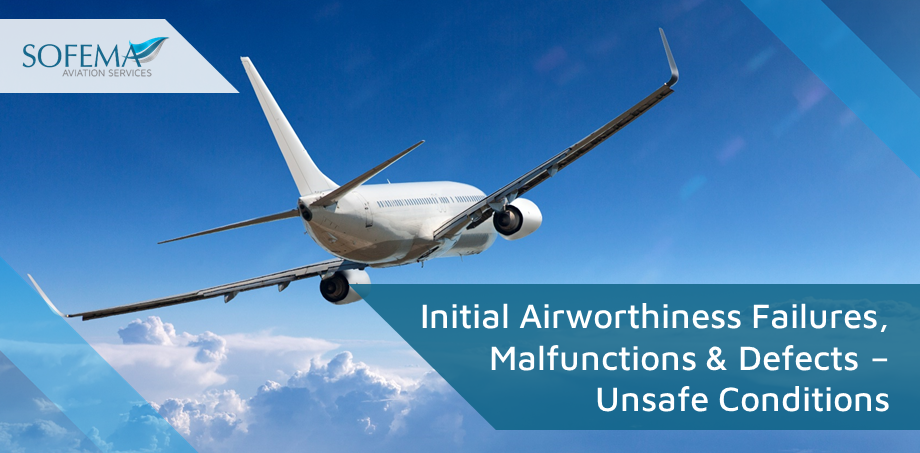Sofema Aviation Services (SAS) looks at the Part 21 Requirements related to AMC1 21.A.3B(b) Failures, malfunctions and defects (ED Decision 2021/001/R) – Flight Considerations
Flight Considerations – An unsafe condition exists if:
- There is a significant shortfall in the actual performance compared to the approved performance (taking into account the accuracy of the performance calculation method), or
- The handling qualities, although having been found to comply with the applicable certification specifications at the time of initial approval, are subsequently shown by service experience not to comply.
Structural or mechanical systems
An unsafe condition exists if the deficiency may lead to a structural or mechanical failure which:
- Could exist in a Principal Structural Element that has not been qualified as damage tolerant.
o Principal Structural Elements are those which contribute significantly to carrying flight, ground, and pressurization loads, and whose failure could result in a catastrophic failure of the aircraft. (See AMC 25.571(a) ‘Damage tolerance and fatigue evaluation of structure’, and in the equivalent material for rotorcraft.)
o Could exist in a Principal Structural Element that has been qualified as damage tolerant, but for which the established inspections, or other procedures, have been shown to be, or maybe, inadequate to prevent catastrophic failure.
o Could reduce the structural stiffness to such an extent that the required flutter, divergence or control reversal margins are no longer achieved.
o Could result in the loss of a structural piece that could damage vital parts of the aircraft, and cause serious or fatal injuries to persons other than occupants.
o Could, under ultimate load conditions, result in the liberation of items of mass that may injure occupants of the aircraft.
o Could jeopardise the proper operation of systems and may lead to hazardous or catastrophic consequences, if this effect has not been taken adequately into account in the initial certification safety assessment.
Systems
The consequences of reported systems components malfunctions, failures or defects should be analysed.
- For this analysis, the certification data may be used as supporting material, in particular systems safety analyses.
- The general approach for analysis of in-service events caused by systems malfunctions, failures or defects will be to analyse the actual failure effects.
As a result of this analysis, an unsafe condition will be assumed if it cannot be shown that the safety objectives for hazardous and catastrophic failure conditions are still achieved, taking into account the actual failure modes and rates of the components affected by the reported deficiency.
The failure probability of a system component may be affected by:
- A design deficiency (the design does not meet the specified reliability or performance).
- A production deficiency (non-conformity with the certified type design) affects either all components or a certain batch of components.
- Improper installation (for instance, insufficient clearance of pipes to surrounding structure).
- Susceptibility to the adverse environment (corrosion, moisture, temperature, vibrations etc.).
- Ageing effects (failure rate increase when the component ages).
- Improper maintenance.
When the failure of a component is not immediately detectable (hidden or latent failures), This failure probability should therefore be conservatively assessed.
- As it is difficult to justify that safety objectives for the following systems are still met, a deficiency affecting these types of systems may often lead to mandatory corrective action:
o Back up emergency systems, or
o Fire detection and protection systems (including shut-off means).
Deficiencies affecting systems used during an emergency evacuation (emergency exits, evacuation assist means, emergency lighting system …) and locating the site of a crash (Emergency Locator Transmitter) will also often lead to mandatory corrective action.
In addition to the above, the following conditions are considered unsafe:
- There is a deficiency in certain components which are involved in fire protection or which are intended to minimize/retard the effects of fire/smoke in a survivable crash, preventing them to perform their intended function (for instance, deficiency in cargo liners or cabin material leading to non-compliance with the applicable flammability requirements).
- There is a deficiency in the lightning or High-Intensity Radiated Fields protection of a system which may lead to hazardous or catastrophic failure conditions.
- There is a deficiency which could lead to a total loss of power or thrust due to common mode failure.
If there is a deficiency in systems used to assist in the enquiry following an accident or serious incident (e.g., Cockpit Voice Recorder, Flight Data Recorder), preventing them to perform their intended function, the Agency may take mandatory action.
Engines
The consequences and probabilities of engine failures have to be assessed at the aircraft level and also at the engine level for those failures considered Hazardous in CS E-510.
- The latter will be assumed to constitute unsafe conditions unless it can be shown that the consequences at the aircraft level do not constitute an unsafe condition for a particular aircraft installation.
Propellers
The consequences and probabilities of propeller failures have to be assessed at the aircraft level, and also at the propeller level for those failures considered as hazardous in CS P-70.
Next Steps
Follow this link to our Library to find & Download related documents for Free.
Sofema Aviation Services & Sofema Online offer Classroom, Webinar & Online Training – Please see our websites or email us at team@sassofia.com
Tags:
Aircraft, Approval, aviation, aviation safety, EASA, Part 21, Flight Data, aircraft design, SAS blogs, Flight, Aircraft defects, Flammability, Corrective Action / Preventative Action (CAPA), Initial Airworthiness, CS P-70





